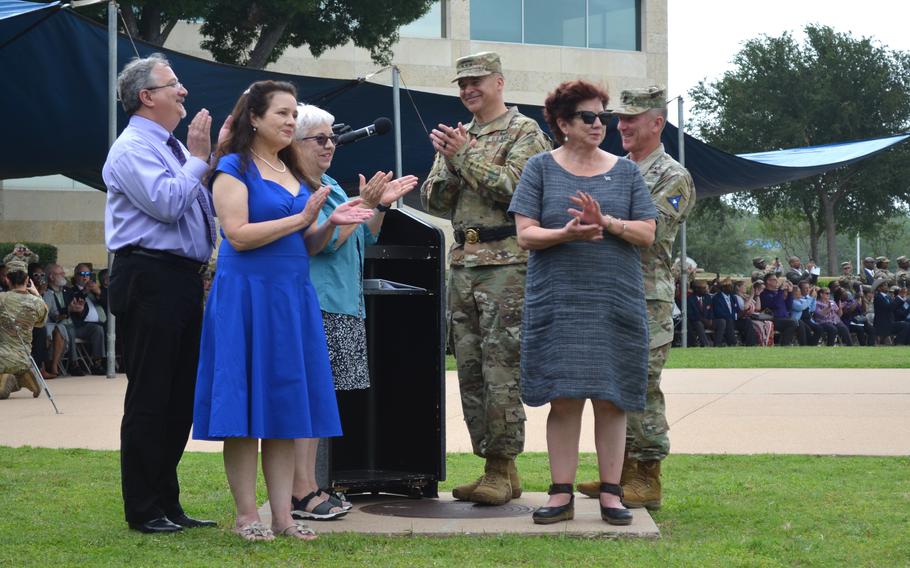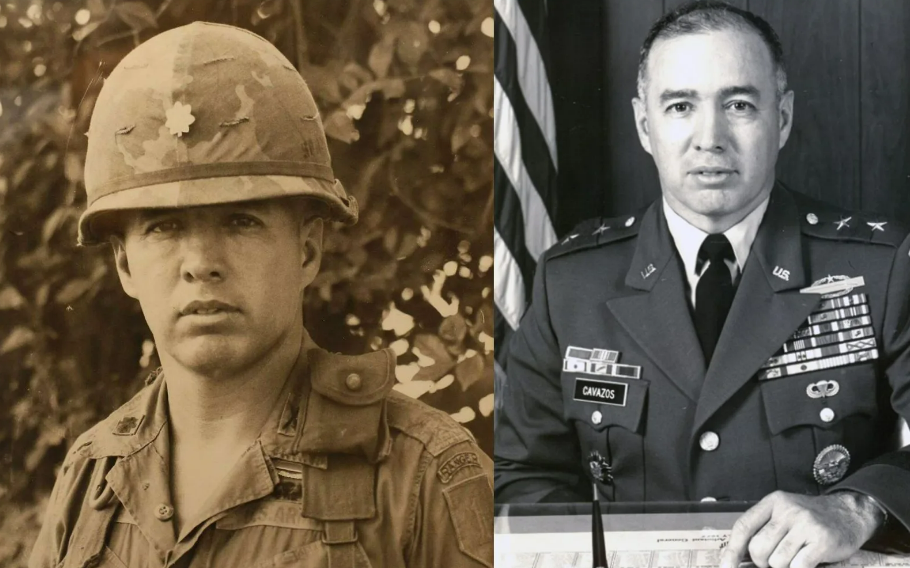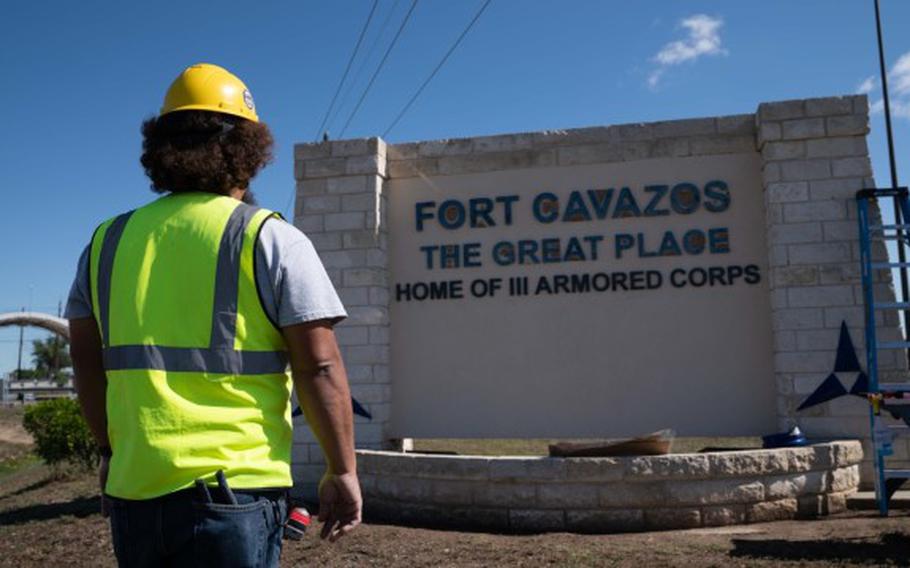.jpg/alternates/LANDSCAPE_910/CavazosCeremonyPhoto07%201.JPG)
A color guard displays the new flag of Fort Cavazos, Texas, during a ceremony Tuesday, May 9, 2023, to rename the base formerly known as Fort Hood in honor of Army Gen. Richard Cavazos. (Rose L. Thayer/Stars and Stripes)
FORT CAVAZOS, Texas — When Richard Cavazos visited a unit, he always asked to meet with the most junior members of the group, retired Lt. Col. James Tucker said of the Army general.
“He would always spend time with the lowest ranking soldier he could find,” said Tucker, who served under Cavazos. “He loved his soldiers.”
Tucker made his comments Tuesday at a ceremony to officially rename Fort Hood after Cavazos, a native Texan who once commanded the base where he developed Army training methods still used today.
“Gen. Cavazos has been described by many as a soldier’s soldier who earned admiration, loyalty and respect through his warrior ethos, through his selflessness, through his genuine empathy and through his unquestionable love for soldiers,” Lt. Gen. Sean Bernabe, commander of III Corps and Fort Cavazos, said during his remarks at the ceremony outside III Corps headquarters at the base.

Members of the Cavazos family and the III Corps commanders clap as they watch the welcome sign unveiled outside of Fort Cavazos, Texas, during a ceremony Tuesday, May 9, 2023, to rename the base formerly known as Fort Hood in honor of Army Gen. Richard Cavazos. (Rose L. Thayer/Stars and Stripes)
Fort Cavazos, which has a soldier and family population of about 53,000, is the fourth of nine Army posts scheduled to be renamed as the military works to redesignate bases that honor Confederate leaders from the Civil War. Fort Pickett, Va., Fort Rucker, Ala., and Fort Lee, Va., have already been renamed Fort Barfoot, Fort Novosel and Fort Gregg-Adams, respectively.
The next ceremonies scheduled are Fort Benning, Ga., on May 11, Fort Bragg, N.C., on June 2, and Fort Polk, La., on June 13. Fort Gordon, Ga., and Fort A.P. Hill, Va., are also to be renamed but dates have yet to be scheduled.
The service-wide effort is expected to cost more than $62.5 million, according to a Defense Department report.
Army Undersecretary Gabe Camarillo spoke Tuesday at Fort Cavazos and said the effort of renaming the nine bases, which was mandated by Congress, was done to shine a light on selected people while recognizing their impact on the Army.
“Today's change is a fitting one because, in many ways, Gen. Cavazos embodied what has always been great about the Army, which continues to evolve and transform, and it's always been enabled by the incredible talent of our soldiers,” he said.

Gen. Richard Cavazos, the Army’s first Hispanic four-star general, served 33 years in the Army and was selected to have Fort Hood, Texas, renamed in his honor. (U.S. Army)
During Tuesday’s ceremony, no one mentioned the former namesake of the post, John Bell Hood, who led a Texas unit during the Civil War. The Army established the 280,000-acre post outside of Killeen in central Texas in 1942 to train tank destroying units for combat in World War II. In time, it has been nicknamed “The Great Place.”
There was also no mention Tuesday of the difficult history that played out at the Texas post during the past eight decades. In 2009, the post experienced a mass shooting that resulted in the deaths of 13 people. Again, in 2014, another shooting occurred in which four people died, including the shooter.
In 2020, following the killing of a soldier on post, the Army formed the Fort Hood Independent Review Commission, which found the quality-of-life of soldiers and families assigned to the base had greatly deteriorated because of lack of trust in leadership.
“We're focused right now on the future of Fort Cavazos, and what it means and what it represents,” Camarillo said. “We think that that sends a powerful message not only to the soldiers that are currently serving today, but to those who are yet to serve in the future.”
Tucker said he wants to see Fort Cavazos be the place where soldiers have the best care possible.
Cavazos, who died in 2017 at age 88, began his 33-year Army career leading a platoon in the 65th Infantry Regiment, which was known as the “Borinqueneers” because it was comprised mainly of Puerto Rican soldiers.
Cavazos was the first Hispanic man to reach the rank of four-star general. He was awarded the Silver Star and a Distinguished Service Cross for his service in the Korean War. He received a second Distinguished Service Cross during the Vietnam War.

A government contractor examines a new gate sign at Fort Cavazos, Texas. (Eric Franklin/U.S. Army photo)
After retiring in 1984, Cavazos worked for the Army to create the service’s Battle Command Training Program, which was later renamed to the Mission Command Training Program, retired Lt. Gen. Randolph House said in his remarks. The program focuses on training Army leaders at the highest levels, and Cavazos was an early adopter of incorporating technology and simulators into the training.
The Army’s swift victory in Desert Storm showcased Cavazos’ work to better prepare leaders for battle, said House, who served as the general’s aide-de-camp.
“He was able to inspire and motivate like no other,” he said of Cavazos leadership and communication. “Gen. [Cavazos] told me it was during his wartime experiences that he began a lifelong quest to focus on training, leadership and taking care of soldiers. When he talked about taking care of soldiers, he did not mean coddling them. He meant bringing them to standard. He believed in tough love.”
With Cavazos’ name on the post, Camarillo said it showcases the limitless opportunity available to those who serve.